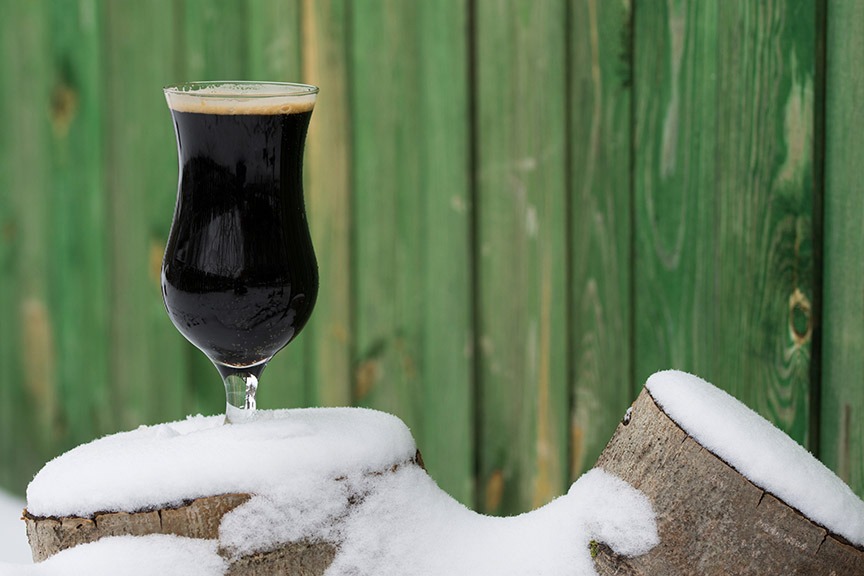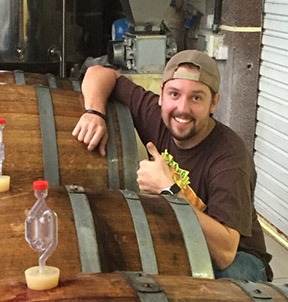A Synergy of Opposites
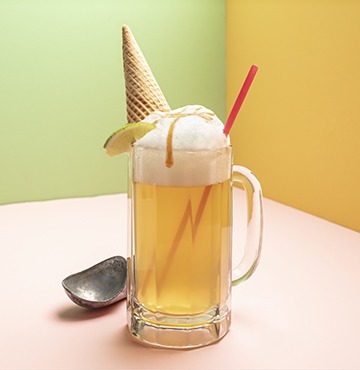
I have a plan. And before you snicker, scoff, or track me down to throw a shoe at me, just hear me out. I found two beer styles that are revered by many (and appreciated by others!) and believe I found a way to improve on both by combining them. I’ve read all of the jokes about brut IPA — here yesterday, gone today — and have seen the message boards from homebrewers and beer snobs decrying what milkshake IPAs and the like have done to “beer-flavored beer.” I’m not going to argue, too hard, with either take.
But, there are aspects I’m not afraid to admit I like about both. With that in mind, I believe I may have stumbled upon a new style that I — and a handful of others I’ve shared it with — believe could catch on. And at least one of those who are on board is a pronounced, well-respected pro brewer who has brewed the style herself. Intrigued?
(Home)brewing Up a New Style
Let’s backtrack. To be clear, I didn’t just brew a batch, declare it the next new sub-style of IPA with my friends, and then write an article for Brew Your Own.
I started homebrewing in 2013. Like many homebrewers at the time, I began with extract brewing. I moved to Brew-In-A-Bag (BIAB) after about a year’s worth of experience, around the same time I joined a homebrew club in Rockford, Illinois. I embraced learning about different techniques, equipment, and ways of approaching things from others in the club and gained a ton of brewing knowledge there as well as through this very magazine and other outlets. The styles I brewed most from the beginning were hoppy beers — IPAs and pale ales. And this still holds true today.
I generally consider myself more of an old school IPA homebrewer. I prefer the style of a West Coast IPA, known for its high bitterness and bold citrus and piney aromas and flavors. Truth be told, the modern West Coast IPA that no longer wants to compete in the IBU challenge of a decade ago is right up my alley.
In recent years I’ve embraced the benefits of adding more late-addition and whirlpool hops and propping up the hoppy flavor and aroma of my West Coast IPAs instead of just focusing on bitterness. This adjustment in my own West Coast IPA got me thinking at some point about what it is I really like about West Coast IPAs. Maybe I really desired a version that was hoppy, smooth, and less bitter?
The truth is, I’m a hophead and if the label says IPA, I’ll try it. So, when milkshake IPAs started becoming more mainstream, I gave them a try. They were never my thing, but I understood the appeal for those who dig them. Then in 2018 when the trend first hit beer publications I started hearing about brut IPAs. I liked the idea of a dry, light beer base that lets the hops shine. I brewed my first brut IPA in July of 2018. It was good, but not going to replace West Coast IPA as my go-to.
Now, a few years later, I thought back to the brut IPA style that sort of came and went. Why didn’t it remain popular? Why didn’t brewers expand on that style? You would have thought (at least, I believed) creating more brut IPA styles would have been what was coming next. This is what got me to thinking about possibly brewing something new. Oh no, not another IPA style!
For those who missed the craze, brut IPAs are a very pale, very dry, highly effervescent variant of American IPA, usually highly hopped with aromatic hops, but with far less bitterness. What made it different was the addition of the enzyme amyloglucosidase that eats up otherwise unfermentable sugar, resulting in a drier beer. The aroma is moderate to intense, featuring one or more characteristics of American or New World hops including citrus, floral, pine resinous, spicy, tropical fruit, stone fruit, berry, melon, etc.
I believe the reason the style was more of a flash in the pan than one that stuck is that the beer lacked body and mouthfeel. It was, of course, brewed to be a very light-bodied beer, but the dryness also added to that perception and took away from the mouthfeel of the beer. The higher carbonation level enhanced those characteristics. True to the design that it was intended to be, of course.
Fast forward to the summer of 2022 and I’m thinking about how I could give the brut IPA what it was lacking (based on my own preferences, at least). Milkshake IPAs are of mid- to high-sweetness. Even more so when fruit is added. But they tend to have lots of body and mouthfeel because of the lactose added. I find lactose enhances the hops in this style as well. Then a bell went off in my head.
What if I add lactose to a brut IPA?
The idea was intriguing, so I took the recipe for that brut IPA I brewed in 2018 and made some minor tweaks plus the addition of lactose. The grains stayed the same — 2-row, flaked rice, and flaked corn, but for the hops I went with El Dorado®, Citra®, and Mosaic® — some of my favorites! I also used Omega Espe Kveik yeast this time since I now brew in Florida, which makes cooling wort down to yeast-pitching temperature in August a challenge. So after brewing I cooled the wort to around 85 °F (29 °C) with an immersion chiller, pitched the yeast, and put the fermenter in my temperature-controlled chamber to keep it at that temperature.
The next day there was a brewery bus trip with a craft beer club I started in The Villages, Florida, called The Villages Craft Beer and Brewing Enthusiasts. The trip brought us to a few establishments in Dunedin, Florida. This is where I met Devon Kreps, Owner of 7venth Sun Brewery. It was a chance meeting for both of us as she was not supposed to be in that day and there were numerous breweries in Dunedin for us to choose from for our brewery stops. After the rush for beers died down a bit, Devon came out and started chatting with us. I explained a bit about our club and what we do and told her I have been a homebrewer for many years.
Not thinking anything of it, I mentioned a bit about the new style I had been thinking about and just brewed — basic details really. I was hesitant to fully describe this beer until it was done and I had a chance to taste it. As the group chatted with Devon we had the pleasure of sampling a couple of her special beers that were off-menu, and had an all-around great time. Afterwards, those of us from the tour headed to our next stop on the tour.
I was shocked when I received a message the next day from Devon. She told me that if I liked the beer I had brewed, that I should bring it to her Tampa location for her to try. If she liked it, she added, she might brew it.
Going Big
Turns out, the beer I brewed was in fact good and I was very happy with how it turned out. About two weeks later I loaded up my Corny keg and headed to Tampa. I feel from the instant she tried the beer she knew that she wanted to brew it, and by the end of our sampling we were determined to find a day to do just that.
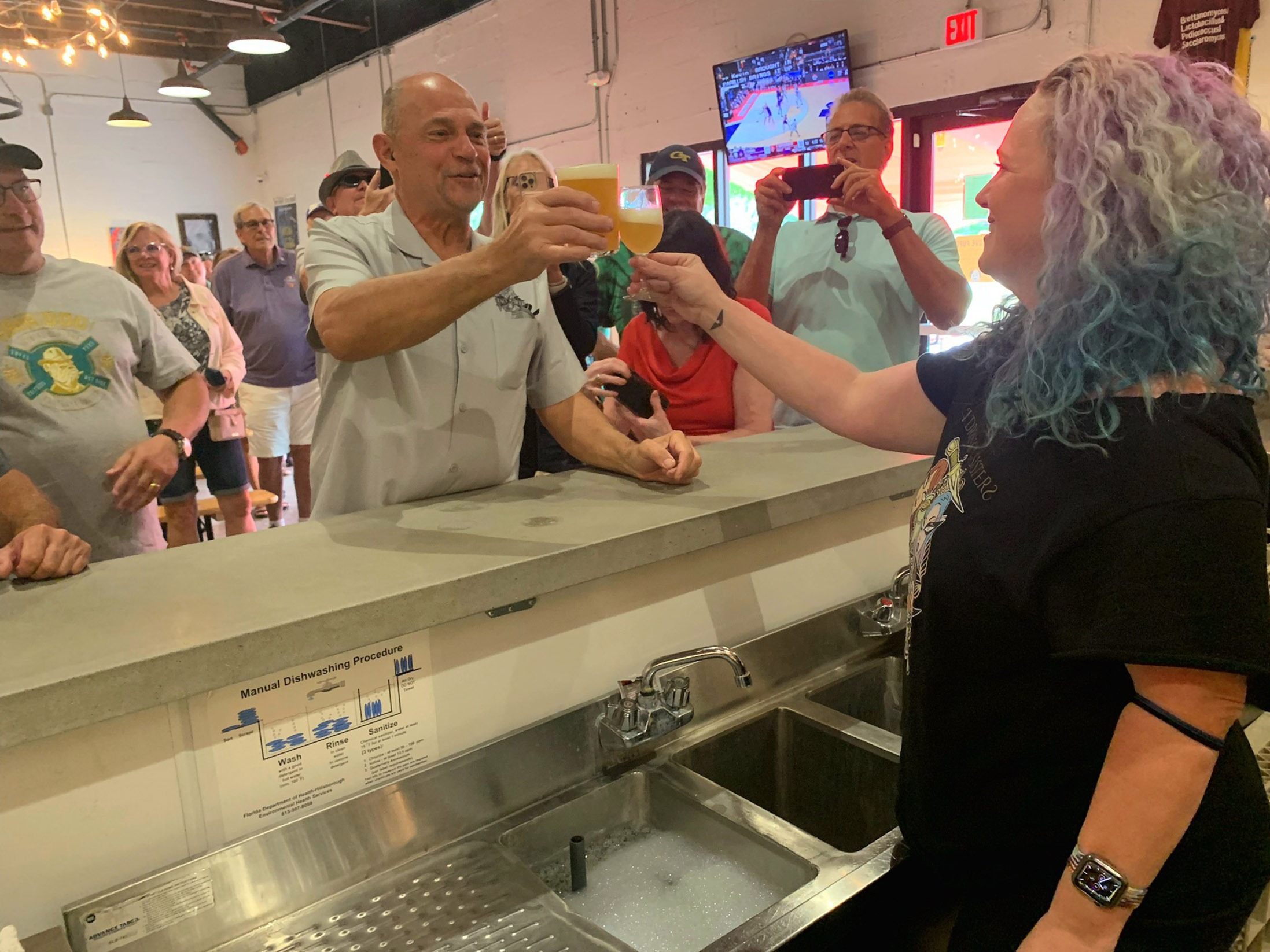
Up to this point I thought I did a pretty good job brewing. My friends always like my beer. At the same time, I figured they are getting free beer so why would they say anything else? I have entered a couple competitions before, but I mostly just brew what I like to drink. To think that a beer of mine would be brewed on a large scale at an award-winning brewery was exciting to say the least.
After working around some scheduling issues on both of our ends, brew day finally arrived on February 20, 2023. The plan was to brew 465 gallons (1,760 L) of this new beer style. This, from a total of one 5-gallon (19-L) homebrewed batch of this style as a pilot brew we’re basing things on. Well, let’s go all in!
We brewed a normal brut IPA recipe adding the amyloglucosidase enzyme in the mash of 2-row malt, flaked rice, and flaked corn. We mashed in at 140 °F (60 °C) for 90 minutes, followed by a 60-minute boil time.
We made a few tweaks from my original homebrew recipe based on Devon’s experience and to better suit the brew system at 7venth Sun. We cut out the bittering hops and made all hop additions Citra® and Mosaic®, which were added near the end of the boil and at the whirlpool stage after flameout.
The lactose was added with 15 minutes left in the boil. After chilling the beer and transferring to the fermenter we pitched Omega Espe Kveik yeast and that concluded the brew day.
Then the wait was on. It was hard for me to not wonder what was going on while the batch fermented and I probably sent more texts than I should have during that time. Fermentation was a bit slower than we expected, but we wanted it to go low so we waited patiently. Anything near 1.010 final gravity (FG) or lower would be great.
In my homebrewed batch, I added 0.5 oz. (14 g) of Amylo™ 300 near the end of fermentation to make it go even a bit drier. But adding the enzyme at the end of fermentation seemed to scrub some of the hoppy aroma. My homebrewed batch finished with a final gravity of 1.004. At 7venth Sun we didn’t add any enzyme after the mash in the big batch recipe as we wanted to maximize aroma. The commercial version that was named False Readings (the story behind the name is with the clone recipe on page 46) finished just slightly higher, around 1.006.
The beer was released at 7venth Sun about a month later, and my beer club of course returned for the debut. The feedback was phenomenal, not just from members of our club, but from regular patrons as well. In fact, during another visit to the brewery a couple weeks later I looked around and observed close to half of the patrons were drinking False Readings. The beer was dank, citrusy, and smooth, with all of the characteristics I like best about brut and milkshake IPAs in one glass, and leaving behind the attributes of these styles that make them so divisive.
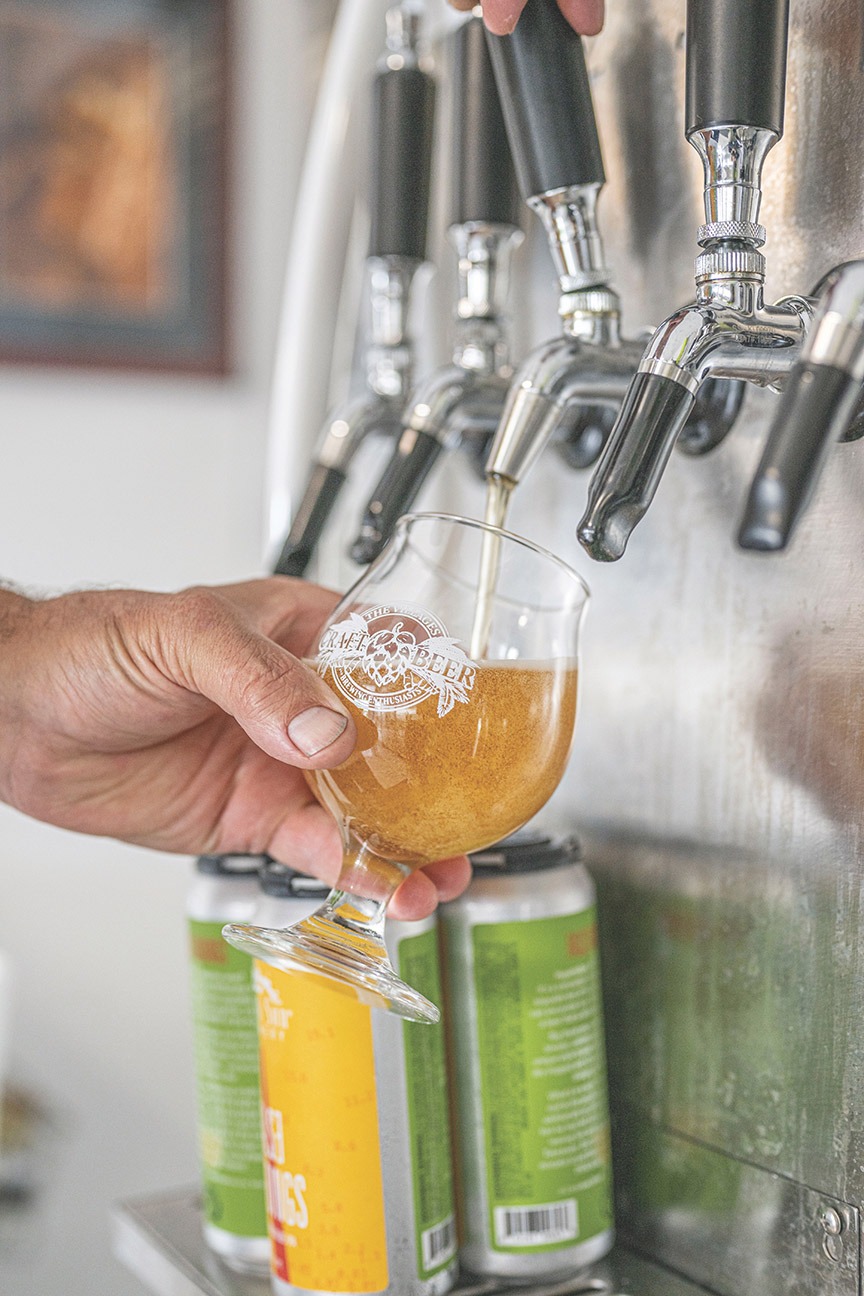
A New Style is Born?
So, what exactly are the characteristics of this hybrid style we named hyperbolique IPA (the sidebar on the top right of this page explains the name)? Well, with just a few batches brewed, I’m certainly not going to say it has yet been defined, but the characteristics are exactly what you would imagine from a cross of a brut IPA with a milkshake IPA: Tropical hops complemented by yeast; a dry malt backbone making it highly drinkable, but with plenty of body; with citrus, tropical, and even piney qualities from hops that I believe all work great together.
Opting for low protein adjuncts, corn or rice are used to balance the high protein malts and to increase drinkability. You can go as high as 30% with the adjuncts.
There certainly seems like a lot of room for experimentation when it comes to yeast, and I’ve yet to really explore those possibilities.
What else I think is neat about this new adventure I’m on working with this general “style” is the possibilities of incorporating aspects of it into existing IPA recipes. Take your favorite American IPA and consider the additions of lactose and amylase glucosidase. The results likely won’t go as low in final gravity as a grain bill that incorporates adjuncts like flaked rice or corn, but some of the attributes will be incorporated. You may question the use of lactose in this situation. Yet, I think even without the adjunct-laden brut grain bill, lactose has benefits. If you think about a New England IPA, there’s a lot of vegetative matter from what goes into the kettle and dry hopping. When you add lactose to your boil, it helps the flavors and aromas in the hops to shine while adding mouthfeel and body to the finished beer. This means you can use less but get more flavor and aroma from the hops used. I’ll take that!
Let’s be honest, I am only a couple batches into this style, but it has piqued an interest. Are you reading this because you are also intrigued? I believe creativity and experimentation are the drivers when new styles are created, and approaching ideas with an open mind are the only ways to find out if that idea has merit.
By exploring this idea I have brewed a couple of beers I really enjoyed drinking, and also have been given the opportunity to co-brew a beer on a large commercial system. In my book, that’s two boxes checked that any homebrewer would appreciate. For now, the only way to know for sure if you’ll enjoy this style as well is to brew your own!
Bringing a Homebrew to the Masses (sidebar by Devon Kreps, 7venth Sun Brewery)
I’m not going to lie, I have tried a lot of homebrewers’ beers over the years and have reason to be wary; some have been award-winning but others not-so-much. When I met Joe back in August 2022, I was so intrigued by this new style he was describing that I told him if his batch tasted good, I’m always looking for something inventive and would love to take his creation to our brew deck.
The idea of it jumped out as highly unique because in essence he took two extremely opposing styles and blended them together. But they also have something in common — with bruts the point is to go dry, but it often throws the beer out of balance, lacking mouthfeel; milkshake IPAs are usually thick, heavy, and sweet, with way too much body. That said, when you combine the essential components of these two styles together, you get something very balanced and beautiful.
So why are we calling the creation a “hyperbolique IPA?” Well as two extremes, I thought the beers on their own are the most of the most: Hyperbole; but I have a background in French and love to employ the use of that language to give it a twist. Hyperbolique is the French translation of hyperbolic, et voila!
7venth Sun Brewery’s False Readings clone
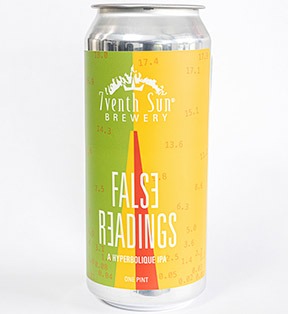
(5 gallons/19 L, all-grain)
OG = 1.054 FG = 1.006
IBU = 39 SRM = 4 ABV = 6.3%
False Readings is the first commercial attempt at the so-called hyperbolique IPA, a cross between a brut IPA and a milkshake IPA. From the can: “What’s in a name? False Readings is both a nod to the perplexing nature of this style, but additionally on collab day, Joe’s gas gauge told him he had half a tank, when in fact it was empty, leaving him stranded on the side of the road. Takeaway: Don’t judge a book by its cover; it’s a mistake to put things into boxes . . . so go ahead and think outside of them.”
Ingredients
8 lbs. (3.6 kg) North American 2-row pale malt
1 lb. (0.45 kg) flaked corn
1 lb. (0.45 kg) flaked rice
11 oz. (312 g) lactose sugar (15 min.)
5 mL AmyloTM 300 (amyloglucosidase enzyme)
7.7 AAU Citra® hops (10 min.) (0.6 oz./17 g at 12.8% alpha acids)
6.8 AAU Mosaic® hops (10 min.) (0.6 oz./17 g at 11.3% alpha acids)
14 AAU Citra® hops (1 min.) (1.1 oz./31 g at 12.8% alpha acids)
12.4 AAU Mosaic® hops (1 min.) (1.1 oz./31 g at 11.3% alpha acids)
2 oz. (57 g) Citra® hops (dry hop)
2 oz. (57 g) Mosaic® hops (dry hop)
Omega OYL-090 (Espe Kveik), Imperial A44 (Kveiking), or LalBrew Voss yeast
2⁄3 cup corn sugar (if priming)
Step by step
Mash at 140 °F (60 °C) for 90 minutes, adding the amyloglucosidase at the start of the mash and mixing well. Raise mash up to mash-out temperature of 168 °F (76 °C) and lauter as normal.
Total boil time is 60 minutes. Add lactose sugar with 15 minutes left in the boil and the first addition of hops with 10 minutes remaining (although you may want to throw in a few pellets at the start of the boil to help break up the foam). In the final minute, add the next hop addition, then turn off the heat and give the wort a long stir to create a whirlpool, then let settle for 20 minutes before chilling.
Chill wort to 85 °F (29 °C), aerate if using a liquid strain, then pitch the yeast. Ferment at 85 °F (29 °C) until signs of activity have ceased. Two days after fermentation is complete, add the dry hops. Allow three days on dry hops, then remove or rack off into a keg and force carbonate to 2.2 v/v or bottle and prime.
Partial mash option
Replace 6 lbs. (2.7 kg) of the pale malt with 3.5 lbs. (1.6 kg) of extra light dried malt extract. Place the crushed pale malt with the flaked grains in a large muslin bag. Mash grains along with amyloglucosidase for 30 minutes in 1.5 gallons (6 L) at 140 °F (60 °C). Then add 2 gallons (8 L) of hot water and stir in the malt extract. Hold for another 30 minutes at 140 °F (60 °C). Wash the grains with 1 gallon (3.8 L) hot water. Bring wort to a boil and follow the remainder of the all-grain instructions, being sure to top off the fermenter to 5.25 gallons (20 L) once chilled.




